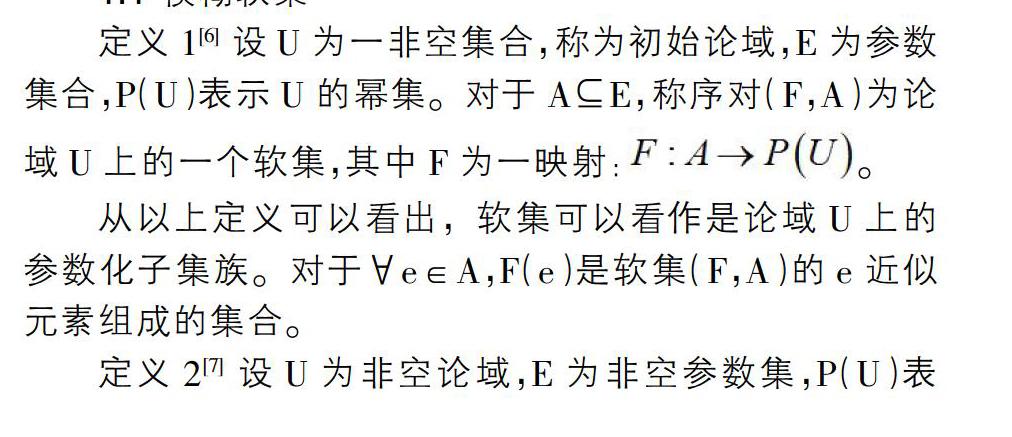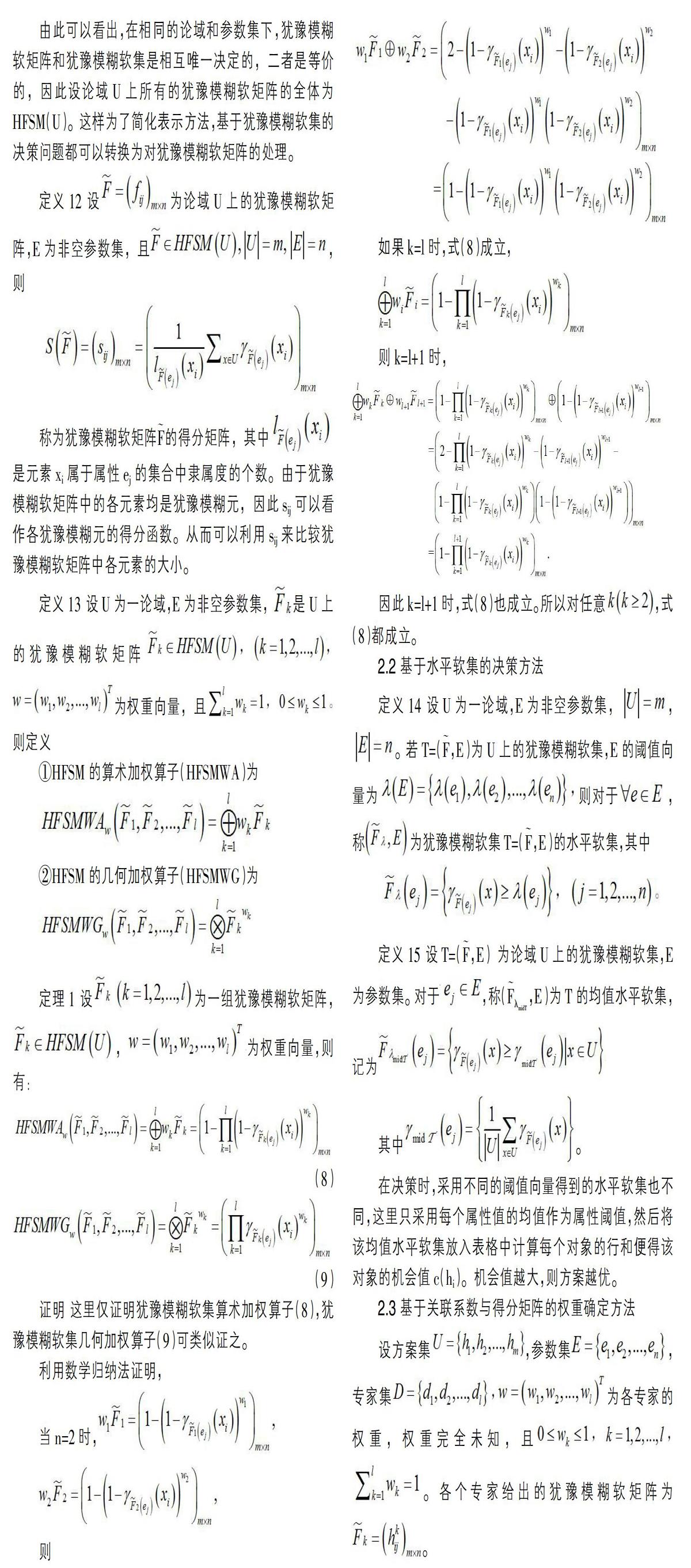猶豫模糊軟集及其在多屬性群決策中的應用
于倩 曹俊 譚玲 廖婭 劉炯艷



摘要:研究了評價值信息為猶豫模糊軟集形式的多屬性群決策問題。首先介紹了猶豫模糊軟集的概念,并討論了其相關運算及性質。考慮群決策中可能存在各專家權重系數完全未知的情況,定義了猶豫模糊軟矩陣及其得分矩陣,并建立基于得分矩陣間關聯系數的最優規劃模型,以此確定各專家的權重。然后,基于猶豫模糊軟集信息,定義了兩種集成算子,即猶豫模糊軟集算術加權算子和猶豫模糊軟集幾何加權算子,并利用水平軟集工具計算各方案的機會值,得出最優決策。最后,提出一種基于猶豫模糊軟集環境下的多屬性群決策方法。
Abstract: Multi-attribute group decision making (MAGDM) problems based on the hesitant fuzzy soft set form of evaluation information have been investigated. Firstly, the concept of hesitant fuzzy soft set (HFSS) is introduced, and the related operations and properties are also discussed. For the situation that the information about experts' weights may be completely unknown, the hesitant fuzzy soft matrix (HFSM) and its score matrix are defined, and the programming model based on correlation coefficient of score matrixes is established to determine the optimal weights. Then based on the hesitant fuzzy soft set, the weighted average operator and the weighted geometric operator are defined, and the level soft set tool is used to compute the choice value of objects to obtain the optimal decision. Finally, an approach to MAGDM problems under hesitant fuzzy soft set environment is proposed.
關鍵詞:軟集;猶豫模糊軟集;多屬性群決策;集結算子;水平軟集
Key words: soft set;hesitant fuzzy soft set;multi-attribute group decision making;aggregation operator;level soft sets
中圖分類號:C934? ? ? ? ? ? ? ? ? ? ? ? ? ? ? ? ? ? ? ? ?文獻標識碼:A? ? ? ? ? ? ? ? ? ? ? ? ? ? ? ? ? 文章編號:1006-4311(2020)03-0283-05
0? 引言
在現實生活中,各個領域都存在著許多不確定問題,從而使概率論[1]、模糊集理論[2-3]、粗糙集理論[4]和區間數理論[5]等描述不確定環境的相關理論得到了廣泛的發展。然而這些理論在其應用過程中也是有一定局限性的。因此為了客觀世界的不確定性本質能更細膩,靈活的刻畫,Molodtsov[6]提出了軟集理論,它是用來解決不確定性多屬性問題的一種數學工具。近幾年來,在軟集理論和其他不確定理論的基礎上人們提出了模糊軟集[7]、區間模糊軟集[8]、粗糙軟集[9]、直覺模糊軟集[10]、區間直覺模糊軟集[11]等概念,并將它們廣泛的應用于不同領域的決策問題中。
Maji[12]等系統地研究了軟集的運算法則,并首次將其應用于決策問題中。Chen[13]等提出了軟集參數約簡的定義,并將其與粗糙集理論中的知識約簡進行對比。Majumda[14]等從另一個角度對模糊軟集進一步泛化,定義了廣義模糊軟集的概念,并討論了它們的運算和相似度,使軟集的應用更加廣泛。文獻[15]通過設定閾值向量提出了水平軟集、約簡模糊軟集等概念,將模糊軟集轉換為經典軟集,再通過計算論域中各對象的機會值以此確定最優決策。文獻[16]提出了區間模糊軟集的概念及其相關運算,同時證明了這些運算滿足結合律、分配律和對偶律。文獻[17]提出了兩種廣義區間模糊軟集的概念,并討論了廣義區間模糊軟集的格結構。文獻[18]在研究了直覺模糊軟集和區間模糊軟集關系的基礎上,定義了直覺模糊軟集和區間直覺模糊軟集的熵以及熵的轉化方法。Alhazaymeh[19]等研究了區間vague軟集及其相關運算和性質。而在實際的決策問題中,由于問題的復雜性和不確定性,在對方案進行評價時,決策者經常給出多個可能的評價值。2014年,王等[20]基于猶豫模糊集和軟集,提出了猶豫模糊軟集的概念。它是傳統軟集理論的一個重要擴展形式。
然而迄今為止,有關猶豫模糊軟集的研究并不多見,因此,本文將其應用到多屬性群決策問題中。首先介紹了猶豫模糊軟集的概念,并討論了它們的運算法則及相關性質。由于在多屬性群決策中,不同專家的重要程度往往會導致不同的最終決策結果。而在某些情況下,專家的權重是完全未知的。鑒此,定義了猶豫模糊軟矩陣及其得分矩陣,通過得分矩陣間的關聯系數建立最優規劃模型,以此來確定各專家的權重。同時定義了猶豫模糊軟集算術加權算子和猶豫模糊軟集幾何加權算子,利用這些集結算子將各猶豫模糊軟集集結為綜合猶豫模糊軟集。最后通過構建水平軟集,給出了一種基于猶豫模糊軟集信息且專家權重完全未知環境下的群決策新方法。
1? 預備知識
3? 結束語
隨著軟集理論在多屬性決策問題中的廣泛應用,其響應的理論研究也已經受到了國內外學者的關注。猶豫模糊軟集作為傳統軟集理論的一個重要擴展形式,目前相關的研究成果僅僅停留在理論研究上。本文將猶豫模糊軟集理論應用于多屬性群決策問題中。首先介紹了猶豫模糊軟集的概念,在此基礎上,討論了猶豫模糊軟集的相關運算和性質。另外,定義了猶豫模糊軟矩陣和得分矩陣的概念,并且考慮到群決策中專家權重可能存在完全未知的情況,基于得分矩陣間的關聯系數構造了最優規劃模型,以此確定各專家的權重。然后定義了猶豫模糊軟集算術加權算子和猶豫模糊軟集幾何加權算子,將各猶豫模糊軟矩陣集結為綜合猶豫模糊軟矩陣。最后利用水平軟集工具,給出了基于猶豫模糊軟集信息且專家權重完全未知的多屬性群決策方法。
參考文獻:
[1]繆柏其,胡太忠.概率論教程[M].二版.合肥:中國科學技術大學出版社,2009.
[2]Zadeh L A. Fuzzy sets[J]. Information and Control, 1965, 8 (3): 338-353.
[3]徐澤水.不確定多屬性決策方法及應用[M].北京:清華大學出版社,2005.
[4]Pawlak Z. Rough sets[J]. International Journal of Computer & Information Sciences, 1982, 11(5): 341-356.
[5]Xu Z S, Da Q L. The uncertain OWA operator[J]. International Journal of Intelligent Systems, 2002, 17(6): 569-575.
[6]Molodtsov D. Soft set theory - First results [J]. Computers & Mathematics with Applications, 1999, 37(4-5): 19-31.
[7]Ikfan Ali M. A note on soft sets, rough soft sets and fuzzy soft sets[J]. Applied Soft Computing, 2011, 11(4): 3329-3332.
[8]Yang X, Lin T Y, Yang J, et al. Combination of interval-valued fuzzy set and soft set[J]. Computers & Mathematics with Applications, 2009, 58(3): 521-527.
[9]Xu W, Ma J, Wang S, et al. Vague soft sets and their properties[J].Computers & Mathematics with Applications, 2010, 59(2): 787-794.
[10]Cagman N, Karatas S. Intuitionistic fuzzy soft set theory and its decision making[J]. Journal of Intelligent & Fuzzy Systems, 2013, 24(4): 829-836.
[11]Jiang Y. Interval-valued intuitionistic fuzzy soft sets and their properties[J]. Computers & Mathematics with Applications, 2011, 61(10): 3179-3179.
[12]Maji P K, Biswas R, Roy A R. Soft set theory[J]. Computers & Mathematics with Applications, 2003, 45(4-5) : 555-562.
[13]D G Chen, E C C Tsang, D S Yeung, et al. The parameterization reduction of soft sets and its applications[J]. Computers & Mathematics with Applications, 2005, 49(5-6): 757-763.
[14]Majumdar P, Samanta S K. Generalized fuzzy soft sets[J]. Computers and Mathematics with Applications, 2010, 59(4): 1425-1432.
[15]Feng F, Jun Y B, Liu X, et al. An adjustable approach to fuzzy soft set based decision making[J]. Journal of Computational and Applied Mathematics, 2010, 234(1): 10-20.
[16]Yang X B, Lin T Y, Yang J Y, et al. Combination of interval-valued fazzv set and soft set[J]. Computers and Mathematics with Applications, 2009, 58(3): 521-527.
[17]Zhou X Q, Li Q Q, Guo L K. On generalised interval-valued fuzzy soft sets [J]. Journal of Applied Mathematics, 2012.
[18]Jiang Y C, Tang Y, Liu H, et al. Entropy on intuitionistic fuzzy soft sets and on interval-valued fuzzy soft sets [J]. Information Sciences, 2013, 240: 95-114.
[19]Alhazaymeh K, Hassan N. Interval-valued vague soft sets and its application[J]. Advances in Fuzzy Systems, 2012, 15: 1-7.
[20]Babitha K, John S J. Hesitant fuzzy soft sets [J]. Journal of New Results in Science, 2013, 3:98-107.
[21]M.M. Xia, Z.S. Xu. Hesitant fuzzy information aggregation in decision making. International Journal of Approximating Reseaning, 2011, 52(3): 395-407.

